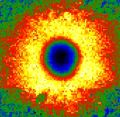Speaker
Description
Investigation of Particle-Plasmon Fields with a Tip and Structured Light
L. Huber*, H. Ditlbacher, U. Hohenester, J. Krenn
Institute for Physics, University of Graz, Universitätsplatz 5, 8010 Graz, Austria
* lorenz.huber@edu.uni-graz.at
We present a combined experimental and theoretical analysis for the mapping of plasmonic nearfields using an apertureless SNOM-tip and a focused laser beam. By varying the relative positions between the plasmonic nanoparticle, the tip, and the laser focus, we obtain information about the excitation and scattering channels.
Introduction
Plasmonic nanoparticles allow squeezing light into extreme sub-wavelength dimensions, a principle that is at the heart of many applications in (bio)sensorics, photovoltaics, or optical data information. Abbe’s diffraction limit hinders the direct observation of the evanescent light fields in conventional microscopy. A popular scheme for overcoming this limit is provided by apertureless scanning nearfield optical microscopy (a-SNOM), where a tip is used to convert the evanescent fields to propagating radiation[1].
Results
In this paper we present a combined experimental and theoretical study for mapping the optical nearfields of plasmonic nanoparticles using an a-SNOM tip and a strongly focused laser beam. In the experiments we fix the position of the focus spot and scan the nanoparticle, the tip, or both, and measure the back-scattered light using a lock-in technique. We have additionally developed a simulation approach for the entire setup, based on the nanobem toolbox [2], whose results are in good agreement with experiment throughout. We show that through our flexible arrangement of a movable sample and tip, we can discriminate the excitation and detection channels contributing to the lock-in signal. In most cases the tip-induced modification of the photonic local density of states provides the major contribution. We finally give an outlook to future experiments and discuss open issues.
References
[1] L. Novotny and B. Hecht, Principles of Nano-Optics (Cambridge Univ. Press, 2006).
[2] U. Hohenester, N. Reichelt, and G. Unger, CPC 276, 108337 (2022); ibid 294, 108949 (2024).

